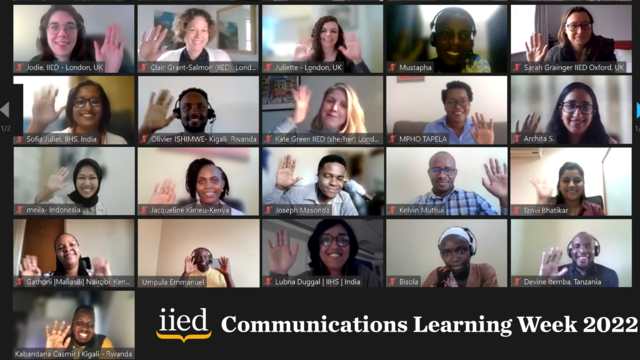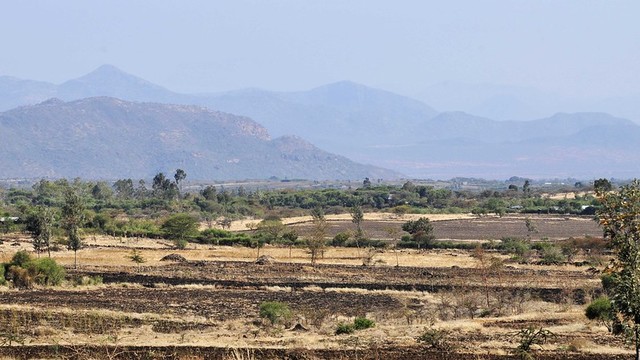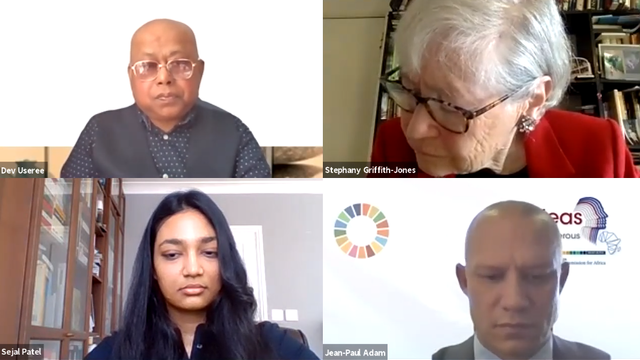More haste less speed? Taking time to learn
Some recent experiences have led Rosalind Goodrich to reflect on the importance of allowing time for learning.


IIED's Communications Learning Week gives participants an opportunity to learn from each other (Photo: Anne Schulthess/IIED)
Another successful Communications Learning Week has taken place at IIED, with four days of mutual learning attended by IIED communications staff and partners. We held the ‘week’ in early July and since then I’ve been in several meetings to discuss potential communication strategies and talk about training sessions, all of which has led me to reflect on how people learn.
Of course, thinking about how people learn is a theoretical discipline in itself, and I won’t pretend to be a specialist in that. My interest is around the specific question of whether we take enough account of the way people learn and the time it takes to learn when planning communication strategies.
A common objective of many strategies I’ve worked on is to ‘build an understanding of X’, with the idea that when they understand ‘X’ more, people are more likely to consider it relevant to the policy decision they may be making.
So, for example, ‘building an understanding of the contribution small-scale fisheries make to the national economy’ might require engaging with people to explain what natural capital accounting is, what kind of data the process yields, and how these data play a part in showing the value added by this sector to overall GDP.
By understanding that better, one would hope a policymaker would be more likely to realise that small-scale fisheries must be considered when formulating fisheries policy, coastal planning policies, waste management policies – and so on.
Natural capital accounts are complex and it wouldn’t be good enough to say that the communications tactic for achieving this objective would consist of sharing a technical report and letting the recipients get on and read it. For starters, they would probably not have the time, and in any case, unless they work in the statistics office, they might well give up after a couple of pages.
A better way to learn
The much better way would be to meet people face to face, discuss how current systems were not appearing to count the full contribution of small-scale fisheries, and share the data, showing – possibly in a visual way – the different picture painted by a different accounting method.
Time for discussion, for listening to and exchanging personal experiences and for resolving any misunderstandings would almost certainly add up to more than the time it would have taken an individual to read the report but it would probably have an entirely different result. Meeting participants would have learnt far more than if they had been left to themselves. This is the kind of approach we tried to take in our work with the World Bank on the WAVES programme.
Day 2 of @iied Comms Learning Week and we are thinking about our stakeholders in detail: Jane the women's group leader in Cameroon & Kumar the agricultural economist in India. How do we reach them and what will get them engaged? #CLW2018 pic.twitter.com/C0JQi81fbp
— Rosalind Goodrich (@RosGoodrich) July 10, 2018
And yet with time a major concern, we often fall into thinking that a quick ‘broadcast style’ session followed by individuals’ reading written materials will be enough – even when dealing with technical material. In my experience, this approach results in remembering the information for about a day before it is forgotten, and the associated materials are never looked at again.
Learning, reflecting on and absorbing the implications of new or challenging information needs time. All the more reason to build regular activities into a communications strategy to reinforce original learning, adding new content when you have it, as part of an ongoing process to build understanding.
Our recent IIED Communications Learning Week emphasised how valuable exchanging experiences is to shared learning. My learning from desk research on communications in Tanzania was given greater depth by conversations with a participant working in Tanzania, for example.
And in-depth discussions about the interests and motivations of our core stakeholders in a ‘persona’ exercise forced us to question what we thought we knew about them, to consider what messaging would really resonate with them and accept that there was more to find out.
View a photo gallery of images from IIED's 2018 Communications Learning Week below, or see the images on IIED's Flickr site.
Bringing together people from different backgrounds and disciplines undoubtedly added to the richness of the conversation. Something borne out many times in IIED’s dialogue work around artisanal small-scale mining, for example.
We’re hoping that our engagement with participants from Communications Learning Week can continue now that they have returned home. Online networks can be a great way to share advice and insights and we’ve set up an alumni Facebook group to continue this exchange.
Offline, in the IIED Communications group we have regular learning lunches to talk about new areas of work, sharing our knowledge and enabling the whole group to learn together. We reflect on completed pieces of work and as a result, often adapt planned courses of action.
It’s this time for collective deliberation, whether internally in a team, in a training session or built into a communications strategy, which I think is so important for building understanding and giving what is learnt the best chance to stick. Time to clarify misunderstandings, time to work out the best way to impart information – text or a series of visuals? – time to work out the implications (the relevance and required actions) of the information if you are on the receiving end.
Communications strategies that aim to build understanding but don’t allow time for learning risk falling into the trap of ‘more haste, less speed’ or in this case, ‘more haste, less impact’. Time spent on thinking about the message, the right format, whether the message needs to adapt, time for engaging with the people whose understanding is critical, may seem like a luxury, but in my view, it’s worth it.



